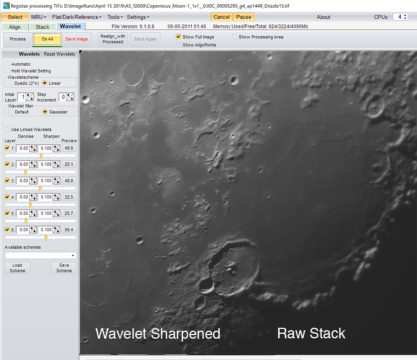
You'll notice that I showed all the modes available in Topaz - I used the recommended settings and turned on 'do additional NR'. Topaz AI in auto modes applies NR in addition to sharpening. I've used Wavelets features in RT5.8 and they make a large difference in results, same for Topaz. But they are not helpful if they do not describe the settings. Comparisons like this are a favorite subject on the 'net. So my opinion, wavelet processing may seem not as sharp as Topaz, but it gives a more accurate result.īoth these programs have settings that influence results. Sharpen is different than focus, but IMO not any better. Stabilize is inventing diagonal features here (they all do, to some extent). Here are all three - focus stabilize and sharpen. The one that I showed in the comparsion above was focus, because I thought that did the best in this situation. You may be aware that Topaz has three modes of sharpening - focus, stabilize, and sharpen. Likewise, the small crater that touches the Rille is practically invisible after Topaz did it's thing, but is clearly visible after RegiStax wavelet processing. Topaz (RHS) thins it out and it looks nothing like the real thing.


Look at that chevron-shaped feture at the top, slightly left. Topaz makes what seems to be a sharper image, but it does so by 'eroding' features. The match is not exact because the LRO image was (probably) taken from directly overhead, while we see this region at an angle. The LHS and RHS images are shown at abou 600%, to match the scale of the LRO image.

This area was visited by the Apollo 15 astronauts. This region of the Moon shows Hadley Rille (slightly right and down from center), which is that sinuous feature in a small valley and has a small crater touching it. Here I compare an image from the Lunar Reconnaisse Orbiter (LRO) in the center, with wavelet sharpening (LHS) and Topaz (RHS) I did a little further adjustment in both of my photos. (I admit I am not an expert in the use of the wavelet technique even tho I've read the tutorials on the subject.)īut we know the 'ground truth' of what we should see in a lunar photo. But Topaz Sharpen AI (also, nfi) can do pretty impressive things, and has very few user-controls to confuse folks. The wavelet sharpening in RegiStax 6 (nfi) is pretty much the standard technique for sharpening lunar images.


 0 kommentar(er)
0 kommentar(er)
